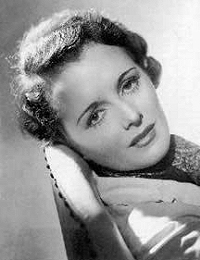 "You're good . . . you're very good," Humphrey Bogart's Sam Spade told her in The Maltese Falcon (John Huston, 1941). And he was right: Astor's Brigid O'Shaughnessy--cool, ruthless, beautiful--to this day retains her reputation as one of the screen's greatest femme fetales. Off-screen, this sophisticated, versatile leading lady led a private life more vivid and eventful than any screenwriter could concoct.
"You're good . . . you're very good," Humphrey Bogart's Sam Spade told her in The Maltese Falcon (John Huston, 1941). And he was right: Astor's Brigid O'Shaughnessy--cool, ruthless, beautiful--to this day retains her reputation as one of the screen's greatest femme fetales. Off-screen, this sophisticated, versatile leading lady led a private life more vivid and eventful than any screenwriter could concoct.
Born May 3, 1906 as Lucille Vasconcellos Langhanke in Quincy, Illinois, Astor became a beauty-prize winner while still in her teens. She came to Hollywood during the silent era, landing extra work and bit roles before becoming John Barrymore's leading lady in Beau Brummel (1924). Astor's elegance and delicate beauty made her one of the most desired women in Hollywood; though only 18 years old, she was a magnet for Barrymore, who courted her right in front of the camera--with her unsuspecting mother watching from the sidelines.
Astor appeared in many costume dramas and swashbucklers throughout the 1920s, including Don Q, Son of Zorro (1925, with Douglas Fairbanks) and Don Juan (1926, with Barrymore again). Talkies found her briefly at RKO--in Runaway Bride (1930), Behind Office Doors (1931), and The Lost Squadron--and at MGM, with Clark Gable and Jean Harlow in the torrid Red Dust (both 1932), before returning to her home studio, Warner Bros., where she costarred in Convention City, The Little Giant, The Kennel Murder Case (all 1933), The Case of the Howling Dog (the first Perry Mason mystery), Upperworld, and The Man With Two Faces (all 1934), to name just a few.
Astor was in the process of a divorce and custody battle with her physician husband in 1936 when her diary, which she had faithfully kept for years, was introduced to the court as evidence. Revelation of the frank descriptions of her affairs, especially with playwright George S. Kaufman, made Astor a notorious figure. But that same year she scored a personal triumph as the lonely American expatriate who fell for Walter Huston in Dodsworth (1936), revitalizing her career.
Astor assumed character roles beginning in the late 1930s, appearing to good advantage in The Prisoner of Zenda, The Hurricane (both 1937), Midnight (1939), and Turnabout (1940), before reaching her career high-water mark in 1941 with her Falcon characterization and her Academy Award-winning supporting role in The Great Lie. She was delightful as a scatterbrained heiress in The Palm Beach Story (1942), and shortly thereafter settled into mother roles, in the likes of Thousands Cheer (1943), Meet Me in St. Louis (1944), Desert Fury (1947), Little Women (1949), and, most strikingly, in A Kiss Before Dying (1956).
Her final films were Youngblood Hawke (1964) and Hush . . . Hush, Sweet Charlotte (1965). As acting opportunities dwindled she turned to writing, turning out five novels, an autobiography (1959's My Story), and one of the best accounts of working in Hollywood, A Life on Film (1967). Astor spent her last years alone in the Motion Picture Country Home, and died there on September 25, 1987.
--LEONARD MALTIN, from
Leonard Maltin's Movie Encyclopedia.